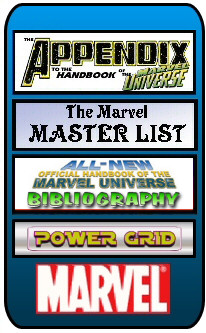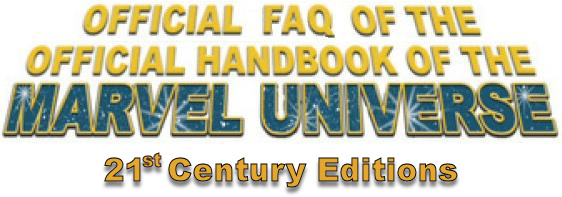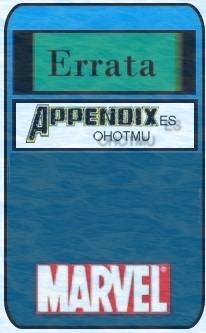


 |
|
 |
Please visit The Marvel Official Site at:
http://www.marvel.com/
and the Official
Site for All-New Handbook Bibliography
Please visit the Unofficial
Appendix Site too, compiled by many of the Official Handbook writers
and friends.
Also worth a visit:
The OHOTMU
Forums at ComiX-Fan
Welcome to the Official online F.A.Q. page for the Official Handbooks of the Marvel Universe. Here we hope to answer some of the more common queries we and Marvel have received regarding the current incarnations of the OHOTMU, as well as providing some errata and other details.
You've made a mistake / missed something out / there's a typo / etc. How do I contact you to tell you about it?
You can either write to us care of Marvel at:
Please mention which character you are submitting, which issue the character is in and a brief explanation in the subject area. For example "Spider-Man 2004: Spider-Man's relatives", "Book of the Dead: Thor's battle with Surtur" or "Women of Marvel 2005: Scarlet Witch's powers". This will help group each e-mail together for a specific error with a character.
Please note that while the various writers have other e-mail addresses, either personal or for their own websites, using these other e-mail addresses to bring up Handbook stuff is likely to mean you will have a long wait before you get a reply, if you get one at all.
What does OHOTMU stand for?
Official Handbook of the Marvel Universe, a series of reference guides which have been released over the years describing and chronicling many of the characters, groups, organizations, places and events which have been shown within that fictional universe.
What Handbooks have been released in the current series?
2004 Official Handbooks
|
2005 Official Handbooks
|
2006 Official Handbooks
|
2007 Official Handbooks
|
|
2008 Official Handbooks
|
2009 Official Handbooks
|
2010 Official Handbook
|
Specials including Handbook-style profiles:
|
What Handbooks are going to be released next?
In 2010 we've just started a new five issue Update series. Specials for the Avengers, Deadpool and others are in the works as well. We're also in the finishing stage for the Hardcovers with all their updates to existing profiles (and some completely new ones).
Have there been other editions of the OHOTMU before this one?
Yes, there have been.
In addition to the above, there have also been a few other guides to aspects of the Marvel universe not considered part of any version of the Official Handbooks above:
What profiles have been covered in the current series, and where can I find them?
For a breakdown of who has been profiled where in all the various and sundry series of Handbooks, there's an excellent and comprehensive list at Comix-Fan. If you just want to check out this series, click on the appropriate letter below.
| A | B | C | D | E | F | G | H | I | J | K | L | M | N | O | P | Q | R | S | T | U | V | W | X | Y | Z |
How do you go about writing each entry?
Once the list of profiles for each book has been chosen, the writers discuss the characters on it, and pick the entries they feel best suited to write. Once each writer has their list, they use a checklist of appearances our head writer, Jeff Christiansen, assembled and maintains, which lists virtually every character in the Marvel universe and where they appeared. From this point we follow similar methods to those established by the writers of the original (and Deluxe) volumes of the Marvel Handbooks (where appropriate and applicable, I will quote original Handbook scribe Mark Gruenwald's words on the subject, because he said it well, and there's no point trying to improve on perfection). The writer goes to the original comics, and reads "through the entry-subject's every appearance in chronological order, making notes of the significant data."
Like the original series (though on a lesser scale) we sometimes "look at the various gaps in the data, be it a never-disclosed real name or an unrecorded episode describing how an entry-subject got from point A to point B where we see it next. We then solicit original material from the writer and / or editor most closely associated with the entry-subject. Writers and/or editors either provide us with the material we request", give us permission to suggest options to fill that gap ourselves "or inform us that they would prefer to keep a bit of information a secret. We are proud to have certain information appear here in the Handbook for the first time anywhere." We also consider cases where there are conflicting historical accounts (inevitable in such an old and large mythos as Marvel's) or gray areas (such as who is actually a member of a team with informal membership requirements and who is just an ally who hangs around), and again, where possible, contact the original writers or original and current editors, to see if a ruling can be made to clarify the situation. Taking the information from these first two steps, an initial profile is assembled - unlike the method used on the Deluxe edition, we do not go to the previous Handbooks until after assembling the initial profile. This is firstly because we do not wish to short-change owners of the original volumes by consciously or unconsciously regurgitating what is simply an updated copy of something they bought many years ago, and secondly because any Handbook entry is a summary of the entry-subject's history, and going to the original comics may bring up relevant aspects of that history missed out from the previous summaries. We do, however, always check previous Handbook volumes where appropriate, as they can be the source of canonical information not given anywhere else; physical dimensions, true identities, names of relatives, and historical background have all been provided for the first (and in some cases only) time in those Handbooks, and must not be missed out if the new profile is to be accurate. Once any such information is added, the draft is then submitted to the writer group for comments and proof checking. Profiles will generally go through multiple drafts, with us repeating the initial steps of re-checking the original comics and querying the people who wrote and edited the character as often as required.
When we have finished our drafts, the profiles are all sent to our editor Jeff Youngquist, who likewise checks through all the profiles for mistakes and unclear information: in many cases, other editors relevant to given sections of the Marvel universe (such as Mike Marts for X-Men related entries) or writers closely associated with given entry-subjects will also check profiles; in all cases, continuity supremo Tom Brevoort scrutinizes our work, correcting anything he feels we have got wrong. Only then, once all these people have checked and double checked the work, does it gain the official Marvel seal of approval, and get sent to be put into Handbook format ready for the printers.
Which characters are going to be covered in forthcoming books?
I'm afraid we are not allowed to tell people who is in forthcoming books ahead of their release. That's the job of the people who write the press releases for Marvel, and we can't step on their toes.
Why haven't you covered (fill-in-the-blank), who is my favorite character / a really important character?
Marvel estimates it has nearly 5,000 "properties" (e.g. characters); over at the unofficial Marvel Appendix site, which many of the Handbook writers are involved with, we've already covered got more entries than that, and we haven't even listed any of the "big names". So far, we've produced some 380 entries over 13 Handbooks, and it doesn't take a Math genius to realize that's only just scratched the surface of what's there. The current format is for themed books, and in some cases, a given character hasn't been covered yet simply because an appropriate theme hasn't come round yet (Speedball, to take a random example, wouldn't fit any of the themes so far); in most other cases, it's because we simply haven't had enough Handbooks to get round to them yet. Groups such as the X-Men or Avengers (for example) have lengthy membership lists and hordes of enemies, and a single Handbook can't contain them all. Even if we were to only give every character within a single page entry, which we don't want to do because it would short-shift many characters, we still couldn't fit them all in a single volume. The Handbooks is a series, not a string of individual and unconnected books, and if you view it this way, the omission of a character from a given volume isn't quite so devastating. Sometimes, when deciding who makes the cut for a given book, we will have two equally worthy candidates vying for a place, and our decision can get swayed by which one is more likely to fit the remit of a subsequent book; if one of the characters could fit into a later book and another couldn't, then the character with more options will get held back. A good example of this was the Rhino; considered for the Spider-Man Handbook 2004, he was dropped to make more space for other Spidey villains, and included in the Hulk Handbook instead.
We've covered just over 420 entries in 15 Handbooks; the most comprehensive of the older Handbooks, the Deluxe Edition, covered just under 900, but it had a 20 volume run plus 8 update volumes to reach this total. Give us some time.
Are there any characters who are out-of-bounds for the Handbooks?
Sadly, yes. Licensed characters for whom Marvel no longer own the license are the main ones; you won't be seeing Rom the Spaceknight, the Micronauts (at least, the ones based on the toys), Conan, Fu Manchu, Red Sonja, Godzilla, the Shogun Warriors, the Human Fly, etc, any time soon. Creator-owned characters are also off limits, so no Groo, Coyote, or Alien Legion, I'm afraid. And obviously we can't do profiles for characters from other companies who have interacted with Marvel characters in various mini-series or one-shot crossovers - in other words, don't hold your breath for the Official Marvel Handbook of the Justice League of America. As reference volumes, we are usually okay to mention most of the above in chronicling the history of Marvel characters who they might have interacted with; we just can't do individual entries for them. There are also some characters who were part of a licensed properties' comic who belong to Marvel Comics - Starshine and Hybrid from Rom, Bug from the Micronauts, Dr.Demonicus from Godzilla, for example - and who we conceivably could cover one day.
Why don't you number characters like the old Handbooks used to?
In the past Handbooks would distinguish between characters of similar name by numbering them (Captain America I; Captain America II; etc). However numbering is an inefficient way of tracking characters who share the same name. Is Betty Ross "Golden Girl I" because she appeared in the real world several decades before Gwen Sabuki "Golden Girl II"? Or, since Gwen was active during WWII and Betty wasn't active until after the war, should the numbers be the other way around? Many people call Adrian Toomes "Vulture I" to distinguish him from Blackie Drago "Vulture II" and Clifton Shallot "Vulture III"...except there were at least two costumed criminals called the Vulture who pre-date Toomes and are simply less well-known than he is (and even more Vultures if you count Robert E. Howard related stories such as Conan). The trouble with the numbering is that
That's why the Handbooks now put the real name (or other clarifier if the real name is unknown or likewise identical) in parentheses after the names of characters where this kind of confusion could arise. It is longer, but makes more sense in the long run.
Why do you number Earths?
Initially Alan Moore started it. In a Captain Britain strip written by Moore, the hero was involved in traveling to a number of alternate Earths, and encountered beings so used to dimension travel that they had numbered each reality the way we number highways. In Daredevils #7, p.8, commentators at the trial of Saturnyne speculated as to which alternate Earth Captain Britain originated from, listing a variety of numbered realities, before his home reality was identified on p.9 by the defendant as as being Earth-616, thereby providing the designator for the mainstream Marvel Earth, which has since been used in titles such as Excalibur, 1602, Exiles and others. Numerous theories as to why Mr.Moore chose that specific number have proliferated across the net since then, ascribing various hidden meanings to it; however we recently asked his daughter Leah Moore and her partner John Reppion if they could ask Alan and solve the mystery once and for all, which they graciously did. The response: 616 "was just a random number of no significance chosen because people always seemed to be talking about "earth 2" or "earth 4" but never any higher numbers."
Earth-616 is the shortest and most concise way we have of saying "mainstream Marvel Earth/reality/universe", and we continue to use this designation in the Handbooks when we need to distinguish characters from that Earth from any extradimensional counterparts. To say "our Earth" would be wrong; last time we checked, our NYC wasn't home to a range of superhero teams. To say "Marvel universe" is inexact; the future timelines of Spider-Girl, the Guardians of the Galaxy, Killraven, etc, are all Marvel universes.
Additionally, we give Earth designators for characters from other realities. While some timelines could be briefly distinguished using the names of the series or imprint they originated from (Earth X, Earth MC2, Earth Mutant X), many more cannot. The meaning of Earth DoFP (Days of Future Past) is no less confusing to a comics newcomer than Earth-811 is. There are two distinct Earth 2099A.D.s. More importantly, some alternate timeline characters have multiple distinct versions running around; Killraven for example (his original series, the version seen in Avengers Forever, the version from his 2004 mini-series, and possibly the one who traveled to Earth X), or Hyperion (the Squadron Supreme version, the Supreme Power version, the evil Exiles version, the Earth-616 version and the older version who traveled to Earth X). By providing a designator number with any such character, a reader can compare mentions of Killraven or Hyperion in different Handbook entries, and know that if the designator matches, it is the same Killraven / Hyperion.
How do I become a Handbook writer?
We're really the wrong people to answer that question. You need to contact Marvel direct - see Corporate Info
Is it true you are "just a bunch of fan writers"?
Every person working on the Handbooks is a fan. However, please don't take that as a negative judgment on either how much Marvel cares about the Handbooks, or on the quality of our work for same. Remember - Chris Claremont was and is a fan; John Byrne likewise; Peter David too. Walt and Louise Simonson - fans. Jim Starlin - fan. Neil Gaiman - fan. Alan Moore - fan. Mark Gruenwald - fan. Joe Quesada - fan. In fact, probably without exception, any artist or writer who started working in comics since the 1960s was and is a fan. Unless you are very successful, there are better paid jobs, and ones with more public prestige; most people working in the industry (on the creative side at least) started doing so because they are fans. And while we don't count ourselves on the same level as the comic luminaries I've listed, my point is that being a "fan" does not mean the work somehow automatically loses validity; instead please judge the Handbooks on the quality or otherwise of our work. Some of the Handbook writers make their professional living as writers; all of us are employed as writers of these books by Marvel. We work as a group collectively reviewing all of the profiles; over time we have assembled a panel of experts that function synergistically to identify the most obscure points, making the material as complete as possible, as well as identifying errata, making the material as correct as possible. All material published is reviewed and sanctioned by both Tom Brevoort and Jeff Youngquist. In addition, any time we are not certain about material, we will send it to the writers of the relevant stories for checking and clarification.
Fans? Absolutely, and proud of it. Just fans? No.
Last updated: 12/12/10